Depositional Facies
Facies Descriptions
Sponge Spicule-rich Wacke-Packstone (SWP):
-
Dark to light gray, olive green, tan, or brown
-
Mottled from burrowing, wispy to wavy horizontal laminated
-
Sponge spicules (mostly monaxon) and their molds are the dominant, and commonly exclusive, grain type
-
Rare echinoderm, bryozoan, gastropod, and peloid grains
-
Moldic, intercrystalline, and vuggy porosity is common
-
Extensively dolomitized (v.f. crystalline or finer; 20 µm - <100 µm)
-
Commonly contains silica replaced evaporite crystals, nodules or coalesced nodules that form layers
-
Silica variably replaces matrix and grains and locally contains matrix, moldic, and vuggy porosity
Mudstone-Wackestone (MW):
-
Similar to SWP facies except identifiable skeletal grains or molds are rare
-
Typically tight; local moldic, intercrystalline, and vuggy porosity
Echinoderm Wacke-Pack-Grainstone (EWPG):
-
Tan to dark brown
-
Typically wispy laminated or mottled texture
-
Horizontal laminations and low-angle cross laminations locally
-
Local fine-grained/coarser-grained layer interbedding and normal grading
-
Echinoderm fragments typically dominant; locally abundant sponge spicules, bryozoan fragments, brachiopods, coral fragments, gastropods, ostracods, ooids, peloids, grapestone, calcispheres, oncolites, and unidentifiable skeletals
-
Extensively dolomitized. Mostly very finely crystalline (< ~50 µm; locally > 150 µm)
-
Where dolomitic, grains are typically preserved as molds
-
Moldic, intercrystalline and vuggy porosity
-
Common partial or pervasive replacement and cementation by chert, megaquartz and chalcedony; typically tight in these areas
-
Where silicified, grains have either been replaced with textures preserved or their molds are filled with silica cement; an isopachous chalcedony cement locally lines primary pores
-
Abundant matrix porosity occurs within tripolitic chert areas.
Sponge Spicule-rich Wackestone-Packstone (SWP) and
Mudstone-Wackestone (MW) Facies
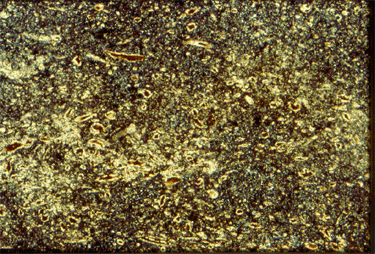 |
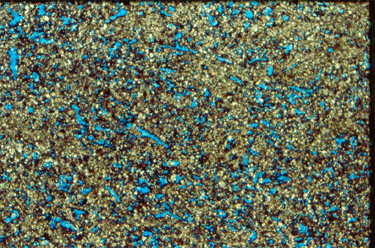 |
| SWP Facies. In this sample the sponge spicules are preserved, much of the matrix is silicified and only a minor amount of intercrystalline porosity is present. Width 5 mm. | SWP Facies. Abundant sponge spicule moldic and intercrystalline porosity in dolomite matrix which tend to form the most favorable reservoir facies. Width 5 mm. |
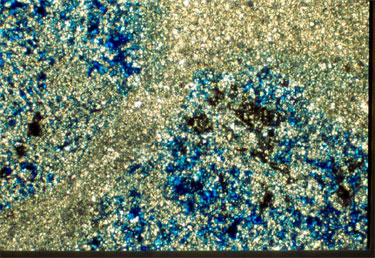 |
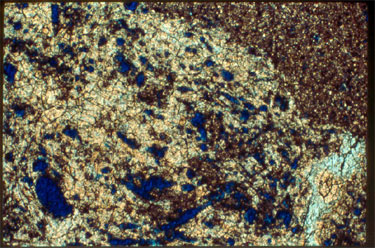 |
| SWP Facies. Burrow mottling created variably tight and porous (blue) areas with abundant moldic and intercrystalline porosity. Width 5 mm. | SWP facies. Sponge spicules have been dissolved leaving molds (dark blue areas) and the surrounding matrix has been mostly replaced by chert. The upper right corner was not replaced by silica and is dolomitic. Width 5 mm. |
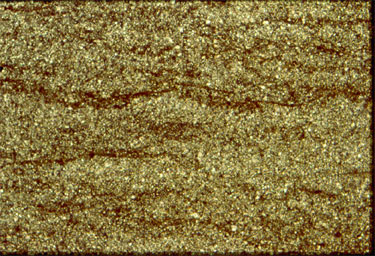 |
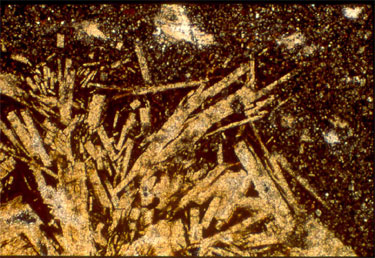 |
| MW Facies. Wispy lamination imparted by clay and horsetail stylolites. This facies is typically tight. Width 5 mm. | Silica-replaced bladed and radiating bladed crystal textures of original evaporite (anhydrite/gypsum) minerals in SWP facies. This sample exhibits displacive growth of crystals and formation of nodules in dolomitic sediment. Preservation of these fabrics suggests early replacement by silica prior to any significant compaction. Width 5 mm. |
Echinoderm Wacke-Pack-Grainstone (EWPG) Facies
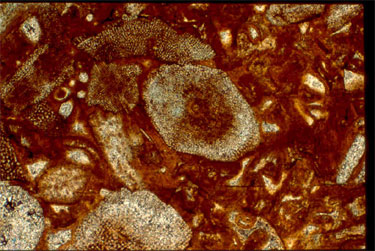 |
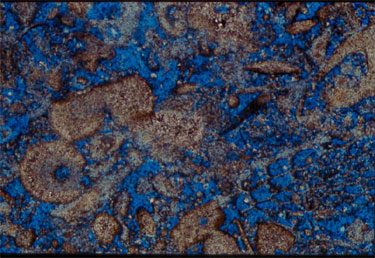 |
| Silicified EWPG Facies. Packstone-grainstone texture has largely been preserved. Echinoderm fragments with textures preserved or molds filled by cement predominate with some identifiable sponge spicule molds filled with cement. Note chalcedony cement (brown) lines primary pores followed by later pore-filling clear megaquartz cement. Width 5 mm. | Silicified EWPG Facies. Skeletal grains, inluding echinoderm, bryozoan, and other unidentifiable grains, have been preserved by silica replacement whereas surrounding matrix has been dissolved leaving abundant interparticle, vuggy, and some intercrystalline porosity (tripolitic texture). Width 5 mm. |
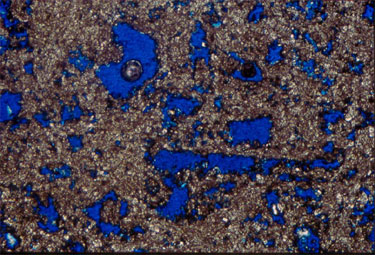 |
EWPG Facies. Echinoderm fragments and other skeletal fragments, including sponge spicules, have been dissolved leaving abundant moldic porosity (blue areas) in relatively tight dolomitic matrix. Width 5 mm. |
Shale and Siltstone FaciesShale and siltstone layers are locally present, typically interbedded with SWP or MW facies. Much of this material is likely related to post-depositional fill, but some layers appear to be associated with deposition during Osagian time. This sample contains mostly angular-subround silt-very fine sand-size quartz grains with minor clay. Width 5 mm. Crossed nicols. |
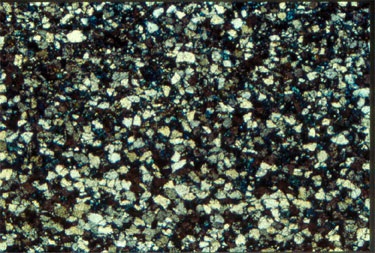 |
|
|
e-mail : webadmin@kgs.ku.edu
Last updated May 2003
http://www.kgs.ku.edu/PRS/publication/2003/ofr2003-32/P2-03.html
